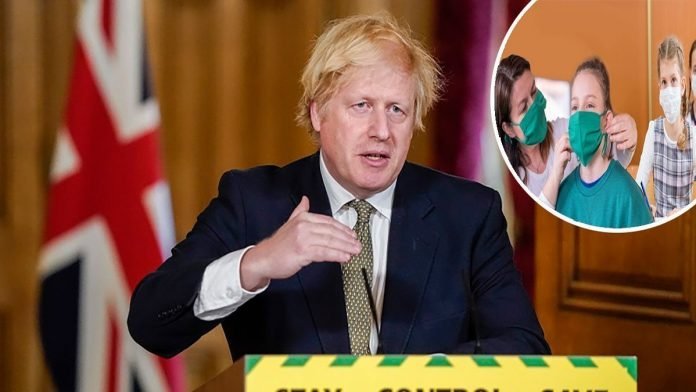
Boris Johnson admits ‘of course’ Covid cases could shoot up as schools reopen.
Boris Johnson has admitted Covid cases could “of course” shoot upwards as schools in England reopen this week.
We all know what is meant by spike, its not just a bar chart, a slide, it’s more deaths more pain and more hurt for somebody’s family.
The Prime Minister said there is a “big budget of risk” that was “just inevitable” – but insisted: “The biggest risk is not opening schools now”.
All schools in England are set to resume full classes this week in a “big bang” reopening despite unions’ calls for a slower, staged opening.
“Of course, there will be a risk of increased transmission, that’s inevitable if you open up schools for millions of kids across the country. That is going to happen,” he told a Downing Street press conference.
Jenny Harries, the deputy chief medical adviser for England, said infection rates remained at the same levels as in late September, even without the effect of schools returning. That was the same period when government scientists became so concerned about infection rates that the government was advised to consider a two-week circuit-breaker lockdown.
The reopening of schools will have an impact on infection rates that could affect the roadmap for lifting restrictions, Boris Johnson has warned as England’s deputy chief medical adviser said it was too soon to rule out a fourth wave taking off.
This begs the question, why English schools are not carrying out a phased return to school that Scotland are advocating.
The Scottish parliament has confirmed that they will be employing a phased return to school for younger pupils.
This will include pre-school children, pupils in primaries 1, 2 and 3, and a limited number of secondary students who need to carry out practical assignments.
From 15 March.
All remaining primary school children are set to return to school full-time from 15 March, with all secondary pupils returning on a part-time basis from that date.
Regulated childcare, including breakfast and after-school clubs, for primary pupils will also re-start on 15 March as part of the Phase 2 return.
From 15 March, all secondary pupils will receive both high quality remote learning and some in-school teaching. Councils will decide how to safely balance in-school learning based on local circumstances and needs.
Senior phase students (S4-S6) who are taking national qualifications will have priority for face-to-face lessons in school.
Updated schools safety guidance to support the phased return will be published next week and Education Scotland will develop practical guidance for schools, which will be also published shortly.
Local authorities will be encouraged to support young people’s wellbeing in other ways – for example, by providing more opportunities for outdoor learning.
Colleges, who can have up to 5% of learners on campus at any one time, will also be able to prioritise senior phase pupils.
For the England its a case of suck it and see
The BBC ask the question: Do children spread the virus?
Among pupils in primary schools, evidence shows that there is limited spread of coronavirus.
But teenagers – particularly older teens – are probably more like adults in the way they transmit the virus.
In the second wave of England’s epidemic in the autumn and early winter, schoolchildren and young adults experienced a much faster rise in infections than other age groups – most likely because they had more opportunities to mingle.
What role do schools play in spreading coronavirus?
This is difficult to say. When schools are open, there is more spread among schoolchildren, particularly those at secondary level. There have also been signs that transmission dips after school holidays, such as half-term.
But it’s hard to say whether children are catching the virus in the classroom, or on the bus or hanging out with friends after school.
Rates of infection in schools tend to reflect rates of infection elsewhere.
An ONS survey of 100 schools in England, which tested random pupils and staff without symptoms, found 1.24% of pupils and 1.29% of staff tested positive for the infection in November, mirroring an estimated 1.2% infection rate in the general population.
Jenny Harries, England’s deputy chief medical officer, has said schools are “not a significant driver” of cases of Covid in communities, although she said children could definitely transmit the infection in schools and elsewhere.
Sage, the government’s scientific advisory group, has suggested opening schools could increase the virus’s reproduction rate or R number by as much as 30%.
But this is highly uncertain and depends a lot in factors like testing, masks and ventilation.
Deputy Chief Medical Officer Jenny Harries warned cases could surge in the next couple of weeks, taking many children out of school, as testing gets going.
Secondary pupils are taking three supervised rapid tests at school over the next fortnight but will then be expected to self-test twice a week at home.
Dr Harries told a Downing Street press conference: “The testing programme in schools should mean that the likelihood of the case going into the school and numbers of children having to come out of education to isolate should be very significantly reduced,
“Just a forewarning here, they may be a very short period at the start of this programme where everybody gets used to it and a larger number of children come out of school, and then it will settle down.
“So I think it’s really important that when observing this people think through to the next three to four weeks, not the next one to two.”
Dr Harries could not rule out the prospect of schools having to close again, saying “hopefully” it will not happen.
It is understood the Department for Education still has a “contain framework” which shut some schools locally in January – available to use again if needed.
Some 4,712 people in the UK tested positive in the most recent 24 hours, a sharp fall, and case rates are below 100 per 100,000 in every region.
But Dr Harries said the level – the same as it was at the end of September – is one from which “a new wave could easily take off again”.
Ministers have said schools will not shut if the R rate tips above 1, as many of the most vulnerable have been vaccinated. Dr Harries said “we do expect there to be an impact on R”.
But she said “education is of critical public health importance just as much as Covid is”, and said some spreading might happen at school gates rather than in classrooms.
Boris Johnson admitted: “Of course there will be a risk of increased transmission – that’s inevitable if you open up schools for millions of kids across the country, that’s going to happen.
“But we think we can do it now in the way that we are because we have the proportion of the population vaccinated that I described, the groups 1-4, having had the immunity bedded in after at least three weeks.”
He said there had been spikes before, adding: “Don’t forget there is a big budget of risk involved in opening schools today in the way that we are – that’s just inevitable.
“We think it’s manageable, we think it’s right, we think we’re prudent…. the biggest risk is not opening schools now.”
Support Independent Journalism Today
Our unwavering dedication is to provide you with unbiased news, diverse perspectives, and insightful opinions. We're on a mission to ensure that those in positions of power are held accountable for their actions, but we can't do it alone. Labour Heartlands is primarily funded by me, Paul Knaggs, and by the generous contributions of readers like you. Your donations keep us going and help us uphold the principles of independent journalism. Join us in our quest for truth, transparency, and accountability – donate today and be a part of our mission!
Like everyone else, we're facing challenges, and we need your help to stay online and continue providing crucial journalism. Every contribution, no matter how small, goes a long way in helping us thrive. By becoming one of our donors, you become a vital part of our mission to uncover the truth and uphold the values of democracy.
While we maintain our independence from political affiliations, we stand united against corruption, injustice, and the erosion of free speech, truth, and democracy. We believe in the power of accurate information in a democracy, and we consider facts non-negotiable.
Your support, no matter the amount, can make a significant impact. Together, we can make a difference and continue our journey toward a more informed and just society.
Thank you for supporting Labour Heartlands











